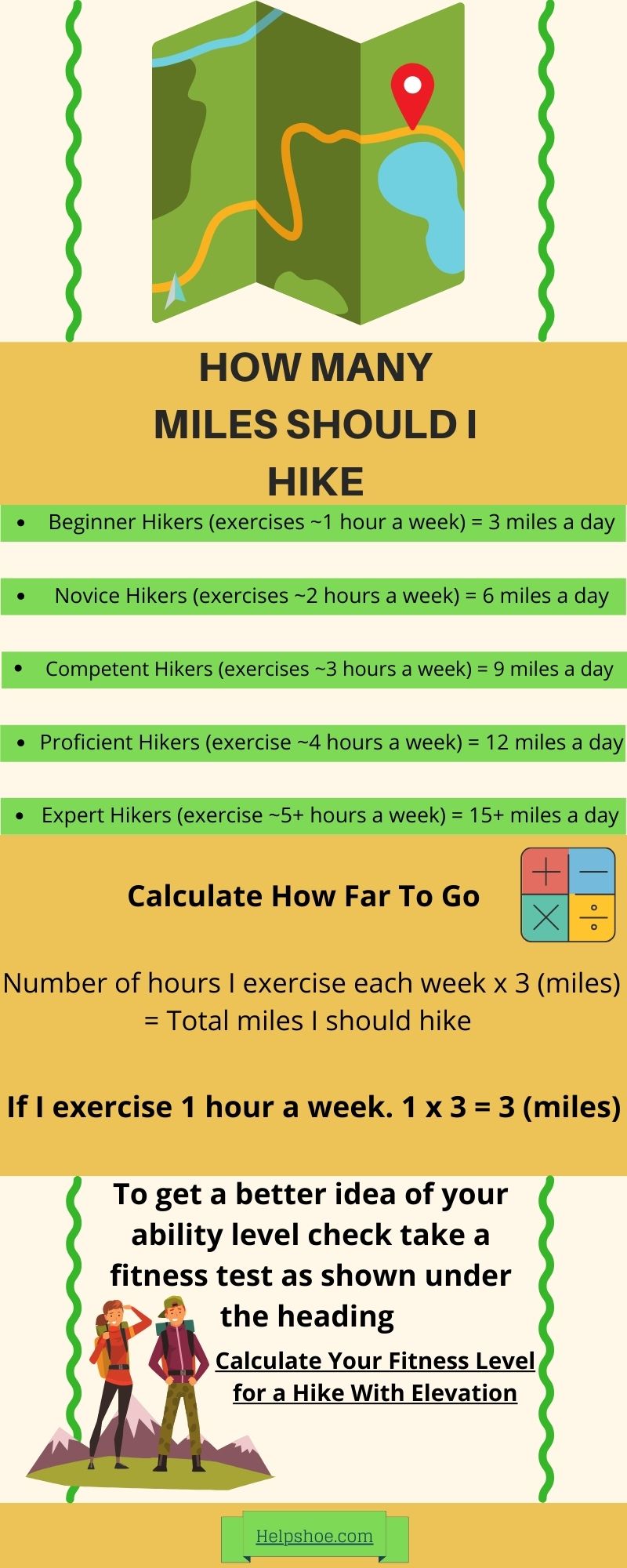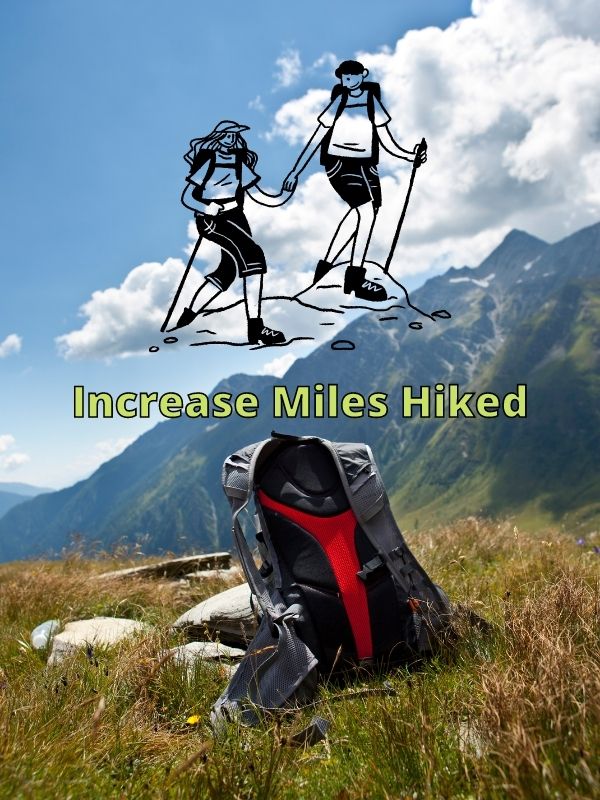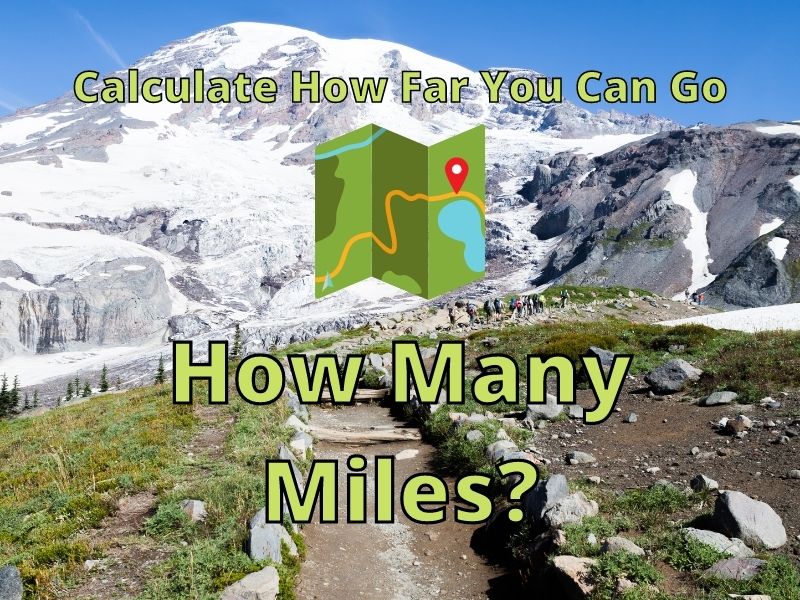Some people may be able to gauge how long they can hike based on previous walking experience. When I walk on the sidewalk about 1.8 miles, it usually takes me 30 minutes. On level ground, this is easy for me, but up a steeper grade hiking trail could take me up to an hour.
Hikers should travel a certain number of miles a day based on their fitness level, pack weight, and trail elevation from start to finish. Based on your normal level of exercise each week, you should hike about 3 – 15 miles a day.
- Beginner Hikers (exercises ~1 hour a week) – 3 miles a day
- Novice Hikers (exercises ~2 hours a week) – 6 miles a day
- Competent Hikers (exercises ~3 hours a week) – 9 miles a day
- Proficient Hikers (exercise ~4 hours a week) – 12 miles a day
- Expert Hikers (exercise ~5+ hours a week) – 15+ miles a day
All of these numbers can change depending on circumstances, but if you’ve been exercising regularly each week the same amount, you will likely be able to complete between 3 – 15 miles fairly well. It’s when you start to get into heavy packs and trails with steep grades, that’s when the number of miles will start to change quickly.
Table of Contents
How to Calculate Hiking Miles I Should Go

I decided to base the number of hours we exercise (moderate to vigorous activity) each week is a good value for a rough estimate of how many miles you can hike in a day.
This isn’t a perfect conversion but it should give most people who have never been hiking a rough estimate of their capability when doing a day hike.
I made the calculation that if you exercise for 1 hour a week, you should be able to walk over 3 miles during that time (on the street) fairly easily. If you have a small pack and are on a trail with some elevation gain, you could go around 3 miles fairly easily in about 2 hours with some breaks.
So for every hour you exercise each week, you should add about 3 miles to your hike. With more exercise, you can handle more miles on a trail by taking breaks and staying hydrated.
Number of hours I exercise each week * 3 (miles) = Total miles I should hike
For example, if I exercise 1 & 1/2 hours a week, I would multiply 1.5 * 3 = 4.5 miles. If I exercise 1/2 an hour each week, I would multiply .5 * 3 = 1.5 miles.
- To calculate hiking mileage, taking leg strength into account, try the calculation below.
Most people can double their normal weekly activity in one day. So if you’re used to walking 3 miles in about 1 hour every week, on a day hike, you could walk 2 hours and still be fine.
So, on a day hike, you should be able to do 3 miles, although it may take you 2 hours, and you may have some aches the next day.
Decide How Many Miles to Hike Before You Go

A beginner hiker can likely hike 3 miles in a day. A day hike is usually defined as one day of hiking, while a travel through-hike will take several days in a row.
If you are going on the trail for several days in a row, the number of miles you should hike will likely be different than a day hike. This is because your legs may not be used to this level of elevation gains, and you will have a heavier pack.
You will need to plan for a shorter number of miles for a multiday hike or plan ahead. You can plan ahead by preparing your body by taking lots of day hikes 6-8 weeks before the multiday hike.
Another factor to consider in deciding how many miles to hike is the trail rating. Trails may be rated as easy, moderate, or hard.
An easy trail may have little to no elevation gains and will not be too long, making it the perfect trail for beginners, younger children, and elderly people.
A moderate trail will have elevation gains, some easy and some more difficult, and will be good for those who are used to walking regularly and have solid leg strength.
A hard trail will have more difficult elevation gains for longer periods and will likely be a longer trail. These are good for experienced hikers who are looking to build their hiking experience and endurance.
You’ll also find that ‘easy’ trails allow you to cover ground much faster than hard trails. A trail that’s rated as ‘moderate’ or ‘intermediate’ features a higher level of elevation gain and will take longer than an ‘easy’ trail.
Finally, trails that are rated as ‘challenging’ or hard will likely take the longest because you need to climb up the trail slowly, and they tend to be longer trails.
Yet harder trails can be the most rewarding, featuring great views, and they may have more interesting natural geological, plant, and animal encounters.
Because of trail rating difficulty and how many days you will be hiking, you should determine how many miles you can travel in a day by adding or subtracting from the number of miles shown at the beginning. Don’t forget about pack weight and the breaks you need to take when calculating how far you plan to go.
Many hikers think that they can travel further than they are capable and soon find out that they should have taken it easier when hiking.
Experienced vs. Inexperienced Hikers

If you haven’t been hiking much, it can be very different than running or some other exercises. You might be in good shape with your cardio but if your legs haven’t climbed hills much, you might be in for a big surprise.
Experienced hikers have built up their cardio and leg strength over time, so they can handle steep inclines over a long period of time.
Those who lack the experience hiking up hills should condition themselves first. This means taking time before you go on a long hike to get your legs (and heart, if needed) used to the climbs and strain that come with hiking.
Depending on how long you are going on a hike will determine how long you will need to prepare. If you are planning an all-day hike with a small pack for some food and water, then you should take at least a couple of training hikes for several hours, even if you are in good condition.
This will inform you about your capacity to hike for longer distances. Try reading my article about 26 tips for long-distance hiking for more information about a long hike.
How Fast Should I Go?

The pace you should go depends on your leg strength and cardio ability. Some people can hike fairly quickly with a light pack.
- Beginner hikers need to take a slow and steady pace and take breaks often.
- Competent Hikers can hike at an average pace for long distances but need to remember to take breaks and set limits so they don’t injure themselves, get dehydrated, or overheated.
- Expert Hikers should have a lot of experience and knowledge about their water and break needs. They may need to step back and remember the number of miles isn’t always what their goal should be.
It’s best to enjoy yourself on the trail and not worry so much about getting to the destination or how fast you’re going, but to enjoy the journey.
Getting to the top of the peak can be a great experience, but those who push too hard can tell you how painful it was the days or weeks after their hike.
Calculate Your Fitness Level for a Hike With Elevation

To get a good idea of how long you should hike for you can test yourself. This is a rough estimate using your cardio ability and leg strength. The best way to test yourself is to hike a similar route to the one you’ll be doing, but make it shorter.
If you want to test at home you can try the following method.
First, you can test your cardio level by running, if you’re used to running, or other cardio activity you’re used to doing. How long can you do cardio comfortably before you need to stop?
Second, on another day you can test your legs strength by using an aerobic stepper or similar platform. Step up and down on the stepper for 5 minutes at a time and take a break by marching for a minute.
If your legs are too tired to go on stop, but if not continue for another 5 minutes. Continue with 5 minutes on the stepper and a 1-minute walking break until your legs are too tired.
Third, you can record the findings of your cardio and leg endurance and calculate how long you should hike.
To do this you would take the two numbers and add them together then divide them by 2. This will give you an average of about how many minutes a day you are able to exercise. Then take the number and multiply it by 5 to represent 5 days of exercise.
(run minutes + stepper minutes)/2 * 5 = Number of the minute you can exercise a week
For example, If I could run for 10 minutes one day and use a stepper for 10 minutes on another, then I would calculate my number of miles to be about 3 miles.
(10+10)/2 * 5 = 50 (minutes)
If I found I could exercise about 50 minutes a week and beginner hikers exercise about 1 hour a week, then I could probably go on 3 miles. (see bullet points for different hikers)
Last, you can decide if the numbers make sense depending on your personal circumstances. If you can run for 60 minutes and step for 20 minutes, but the hike is mostly on flat ground, then I would probably take the 60 and forget about the 20 and multiply 60 * 5 to get about 5 hours of exercise.
Then I would guess I could go 12-15 miles on a day hike.
Terrain and Elevation
The flatter the terrain is the faster your pace will likely be and the more ground you can cover in a shorter amount of time. On trails with higher elevations, you’ll spend more time climbing, navigating, and maneuvering terrain.
To get a better idea of what the trail is like you can use google maps to get a 3D version of the trail that you will be climbing up or you can use an app like Alltrails.com to see if the trail is mapped for you already.
By learning the difficulty level in advance, you’ll be able to make a more accurate estimation of how much ground you’ll cover and how quickly.
The Weight of Your Backpack
The weight of your backpack can significantly impact how much ground you’re able to cover in a day. It will also impact your legs and back if your carrying too much and aren’t used to it.
A backpack that’s made with heavier materials and packed with a lot of supplies will weigh you down and force you to exert more effort and energy during your hike.
A day hike can be comfortable with light backpacks and a few key supplies.
Trail Conditions
If a trail is covered with snow or ice, you may have a hard time. Not only will you have a hard time maintaining a decent pace, but you’ll have a hard time making sure you remain on the trail.
Decide if you need shoe spikes, hiking poles, and waterproof gear. You can limit the number of planned miles you will go based on what you expect to find on the trail.
The issue of trail visibility isn’t exclusive to winter trails and is often found on summer trails that have been poorly maintained.
Carrying a phone with GPS can be VERY HELPFUL. Some people use apps to track their progress and guide them.
Weather
The weather plays a role in how many miles you can hike. Intense heat will make you sweaty, sluggish, and you’ll need to take more frequent water breaks to prevent dehydration.
Prepare your gear accordingly and adjust your mileage to the demand that may be placed on you.
How to Increase Miles Hiked

To become a seasoned long-distance hiker, you’ll need to put in the effort and train hard. It takes a consistent effort week after week of hiking to safely and effectively increase your miles hiked.
Runners often spend months training for a marathon before doing it. The longer they train the less likely they are to get injured.
Your body needs time to adjust to more miles, but you can also prepare yourself with food and equipment for a better hike that may lead to more miles.
- Lighten your pack of anything you really don’t need. (You need some food, water, medical kit)
- Switch to lighter footwear such as trail running. (If your foot and leg strength is low, then comfortable hiking boots would be better because of the support they provide.)
- Use hiking poles. They can support you ascending and descending and help you feel less tired.
- Drink water often and eat enough food. If you will be sweating, gaining elevation, and out in the sun, you may need more water than you think. Some people can benefit from an electrolyte mix for their water
- Packing enough food, trail mix, or energy bars can make a difference in your overall energy.
- Keep a steady pace. Don’t go too slow or too fast. It’s more efficient to keep the same pace. I’ve been on a hike where I just kept a steady pace and it made a big difference in how much energy I had.
You also need to remember that hiking can pose other issues if you’re not ready. Blisters, chafing, aches, cramps, and fractures are all common occurrences on trails.
Being prepare will make a difference in how many miles you can go during your hike.
Should I Go on a Long-Distance Hike?

A long-distance hike can be lots of fun. If you are willing to take the time to do it right you can have a great experience. If you’re considering a long-distance hike, consider the following tips.
Think about how ready you are. Then you’ll be able to decide for yourself.
Go Hiking Early
Seasoned hikers tend to agree that an early start is key to a successful long-distance hike. A great way to ensure that you can hit the trail early is by organizing your gear and supplies the night before and packing your backpack in advance.
Get up before dawn and start your hike.
Hike as Light as Possible
The less weight you have on your shoulders, the faster you’ll be able to travel and the more distance you’ll be able to cover.
Your first step to traveling light is to opt for a lightweight backpack as opposed to one of heavier construction. From there, your focus should be on reducing your overall backpack weight.
If you want to be able to hike over 15 miles per day, you need to pack your backpack wisely and only include food and supplies that are essential.
Wear Proper Hiking Shoes
Don’t even attempt a long-distance hike if you don’t have proper hiking shoes. A good pair of hiking shoes are comfortable to wear and support you for your level of hiking ability.
Remember that intensive activities such as hiking may cause swelling of the feet, so consider stretchy shoelaces or getting a size larger hiking shoe. By purchasing good hiking socks you’ll be protecting your feet and avoiding issues.
Break Your Hike into Segments
Sometimes our insecurities are our own worst enemy. Hearing that you’ll have to tackle a 15-mile hike in one go can be daunting and leave you doubting yourself and your capabilities.
Instead, break the total distance into smaller segments that you’re more comfortable with. Eight 3-mile sections sound a lot easier to conquer than one 15-mile stretch.
Postpone Breakfast Before Hike
We’ll be the first to agree that there’s nothing quite like a good breakfast while camping.
Unfortunately, a big meal before a hike isn’t always a good idea because it can lead to cramps.
A better idea is to eat part of your breakfast or a snack before hiking and then enjoy the rest of your breakfast once you’re ready to take a break after a couple of hours.
Eat Snacks on Your Hike
You may not need to eat lunch on a long hike. Instead, you can snack on food while hiking. You’ll be able to finish enough food during little breaks and snacking during the hike to give you the calories needed for a lunch-sized portion.
Pace Yourself on Your Hike
Pacing yourself is a key to many activities. A pace of around 2 or 3 miles per hour is considered moderate and can be done by many on a moderate level trail.
A good way to tell if you’re going too fast is by monitoring how often you have to stop to rest or catch your breath.
Take Breaks on Your Hike
Take an approach of ‘prevent rather than cure’ when it comes to hiking. Stop to rest at least every two hours to assess how you are doing. Getting caught up in the need to get to the destination can leave you forgetting to eat some or the need to take care of your feet.
Take a Nap on Your Hike
Yes, taking a nap is great on a hike. If you’ve been hiking a couple of days, you may not have slept perfectly the night before. Take a 20-minute snooze to refresh yourself.
Track Your Hiking Time and Distance
You want to know how well your body is doing and when it’s best to head back to the start of your hike. Checking the time and distance every couple of hours will help you manage when and where you will be by the end of the day.
Rest Before Your Hike
Try to rest the day or two before a long hike. Your body needs to be ready for a challenge and too little sleep or energy may result in a poor hike. Eat enough, sleep enough, and try to destress before your hike.
Final Thoughts
You can estimate the miles you should hike based on your normal weekly activity. If you are planning a hike, it’s a great idea to work up to it by taking smaller hikes.
Being prepared is your greatest tool to help you have a successful hiking experience. Then you can travel as far as your fitness level allows you without having any other problems that can occur during a hike.
Thanks for visiting Helpshoe.com

